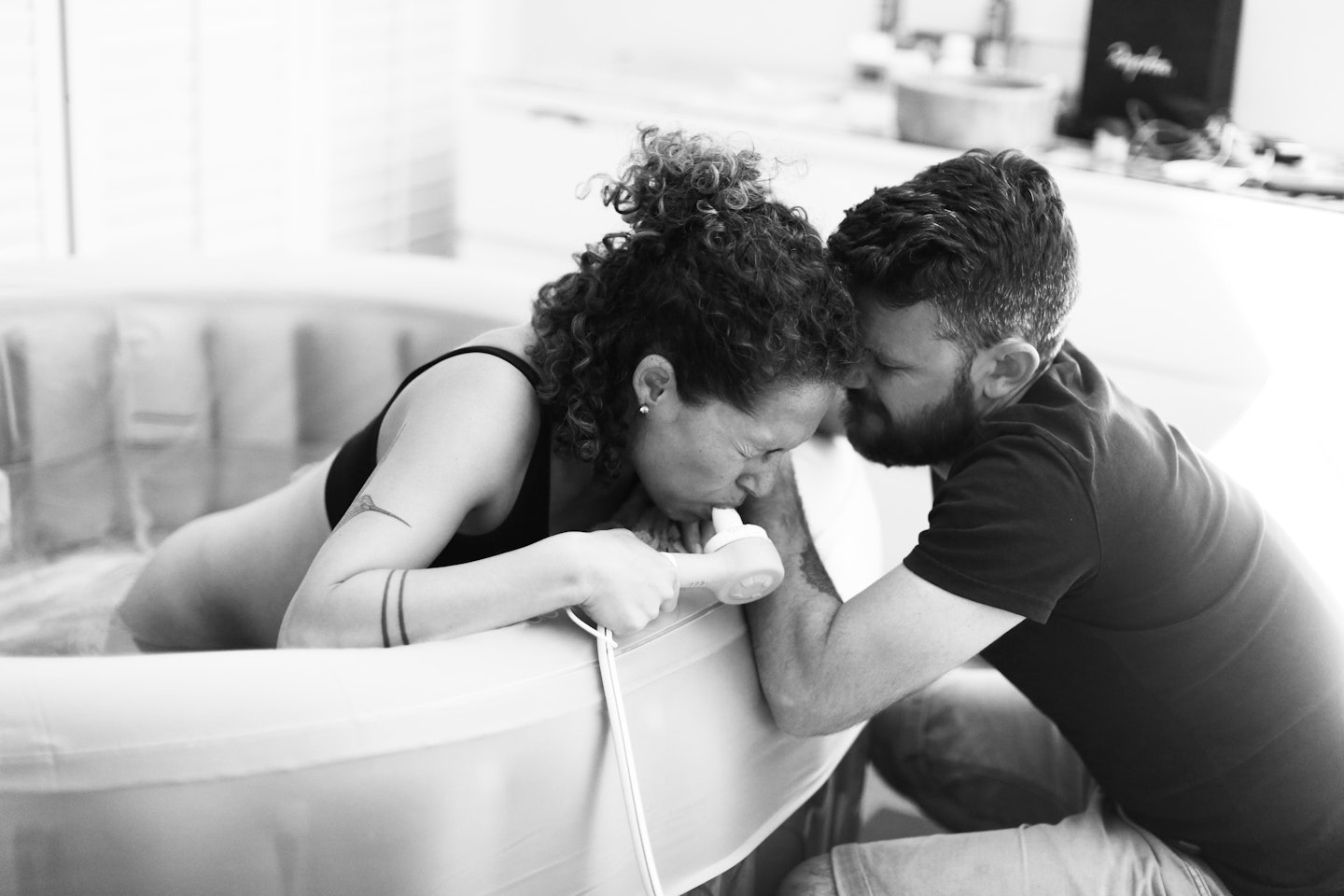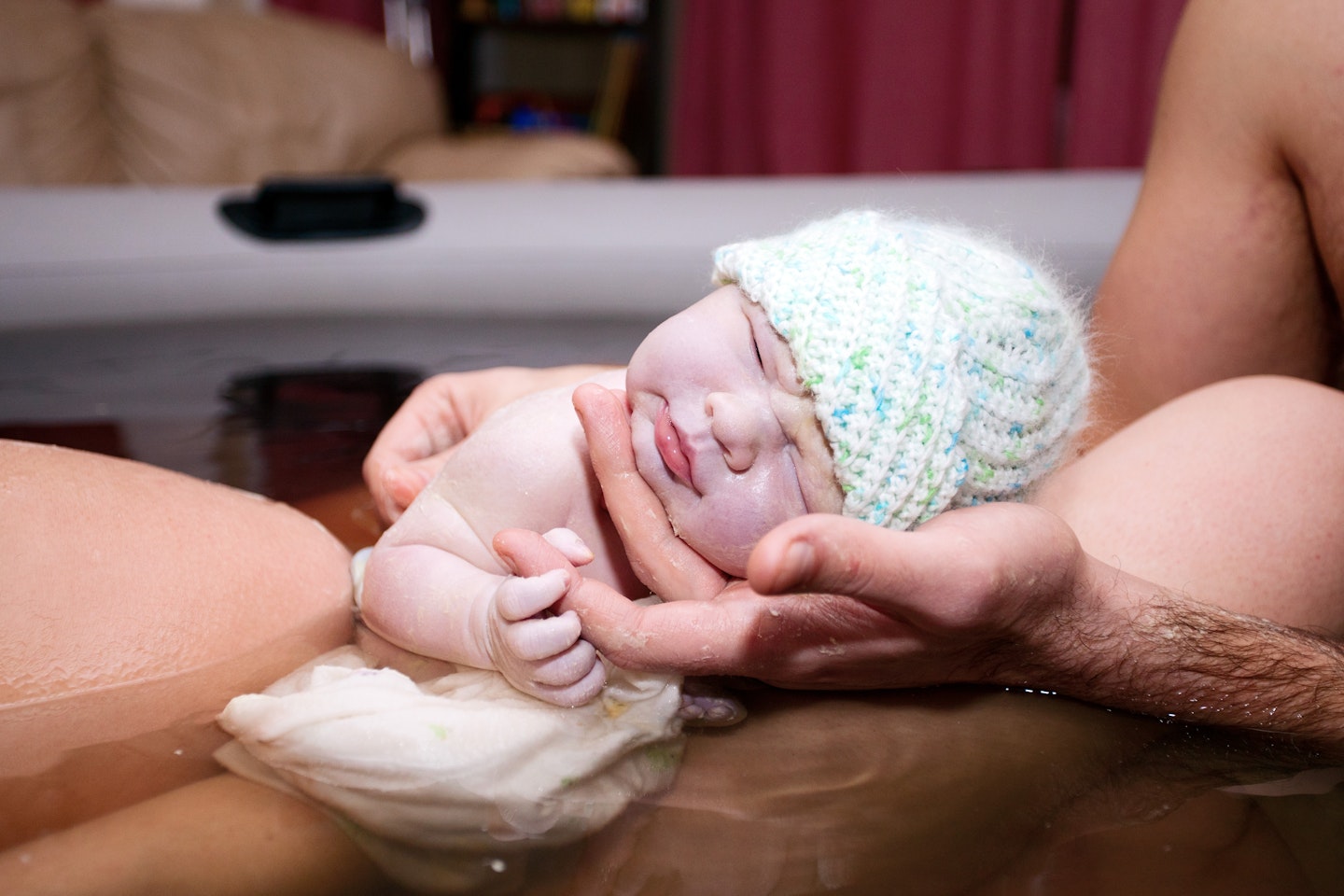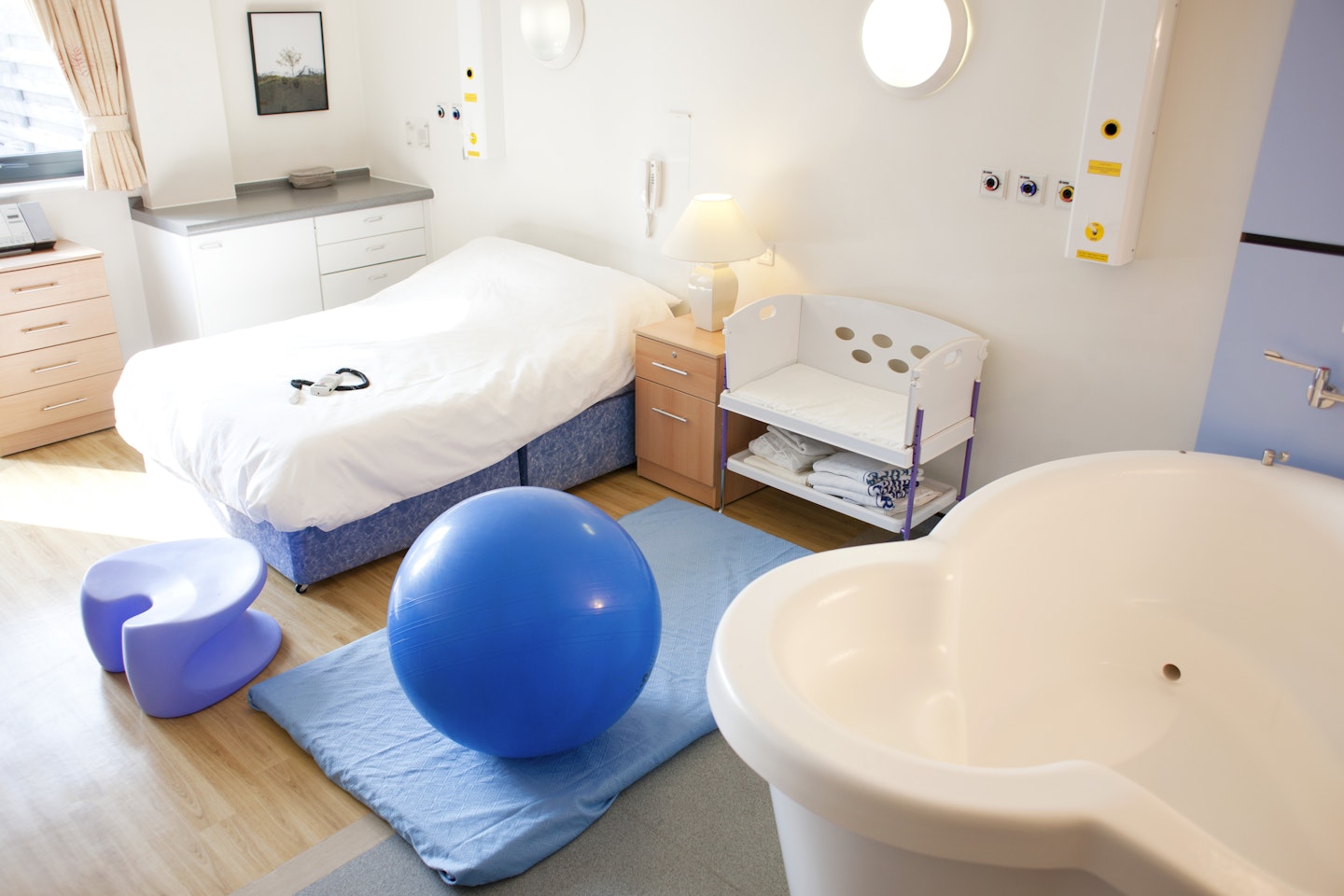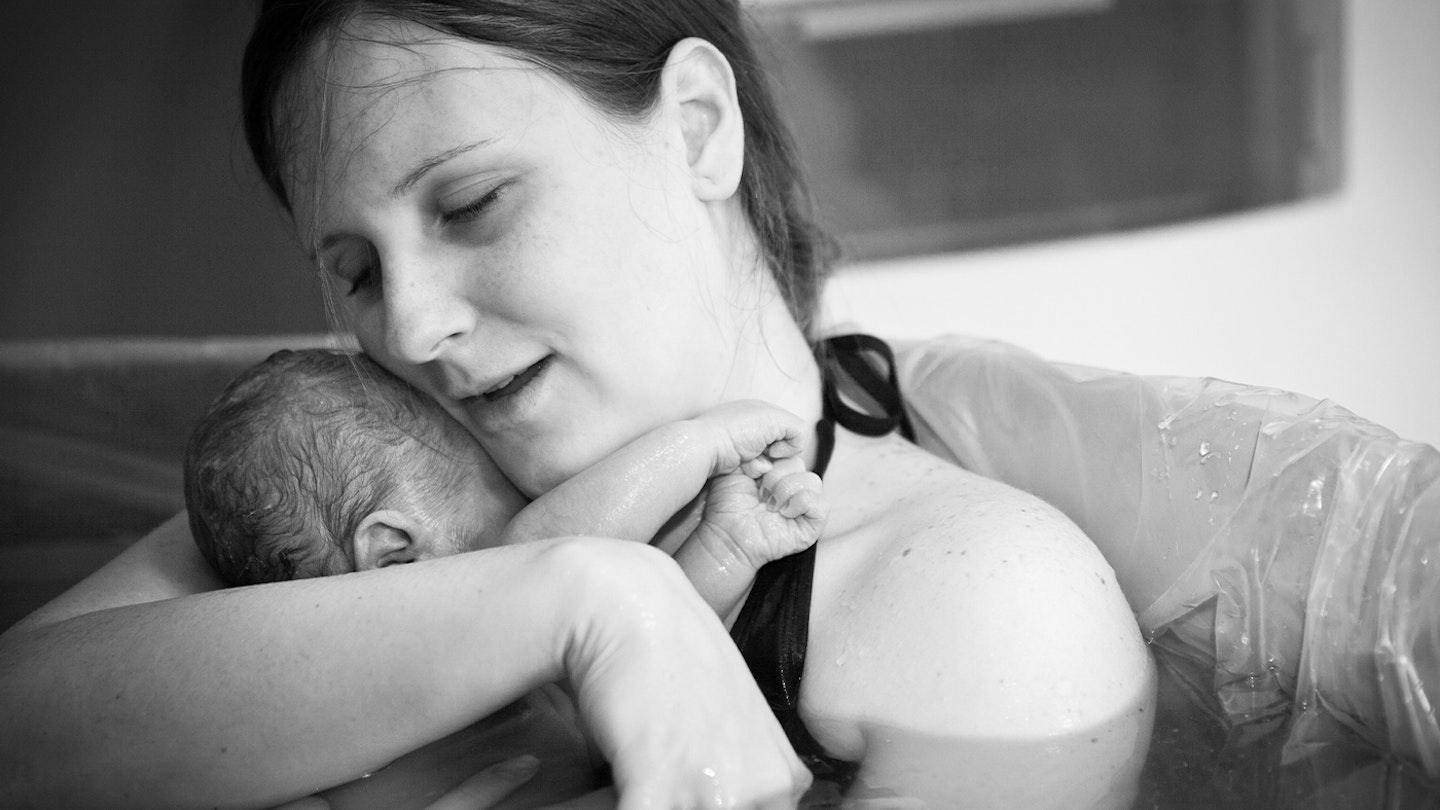There are many different ways that you can choose to give birth — from a vaginal birth to an elective C-section — however giving birth in a pool, known as a water birth, is growing in popularity. According to the National Childbirth Trust, around 10 per cent of women in the UK are now having water births, but is it the right birthing method for you?
Below we explore everything you need to know about having a water birth, from the advantages and disadvantages, who can have a water birth, what pain relief is available and advice on what you should wear should you choose this birthing method.
What is a water birth?
Quite simply, a water birth involves giving birth in water, whether that's a deep bath or a birthing pool.
Many birth centres and even obstetric units have birth pools, but you can also buy or hire a birthing pool if you choose to give birth at home. Around one-in-five women spend time during labour in water — be it in the shower, bath or birth pool — before giving birth.
However, it’s not classed as a water birth unless you actually deliver in the water. In some cases, some women spend a lot of time during the first stage of labour in the water, but when they progress into the second stage the midwife may ask a woman to exit the pool. This can be for things like to get in a better position to help travel through the birth canal easier.

Can I have a water birth?
"Most women can have a water birth if you are having a low-risk pregnancy and birth without any complications, and most maternity units offer them," says Alessandra D’Angelo, Quality and Standards Advisor, Royal College of Midwives.
If you're unfamiliar with the term, 'low-risk pregnancy' this refers to the majority of pregnancies and in most cases applies to the below:
• If you're pregnant with one baby rather than with multiples
• If your baby's head has dropped into the head-down position in preparation for birth
• If you've had a healthy pregnancy throughout with no complications
• If you're full-term when going into labour
• If you've not developed any problems when going into labour
"For women with symptoms or a positive COVID-19 result, we recommend an individual discussion with your midwife. You may be advised against water birth in these circumstances, to keep you and everyone around you safe."
If this is something you are interested in pursuing or finding out more about, you should speak with your midwife or doctor.
Why you might not be able to have a water birth
For pregnancies which are considered 'high-risk', it's unlikely you'll be able to have a water birth. This is because doctors or midwives may need to intervene during labour and you may need an assisted birth or even emergency c-sections in some scenarios which cannot be carried out while you're in the water.
• If you have a history of heavy bleeding during pregnancy
• If your baby is breech - depending on what stage of labour you're at, your doctor may decide it's safer to give birth to your breech baby via c-section rather than vaginally.
• If your waters have been broken for over 24 hours
• If you are induced
• If you have previously had a C-section
• If you have a medical condition such as diabetes or epilepsy
• If you go into labour prematurely (before 37 weeks)
• If you have an infection
• If you are having twins or triplets
According to practising Midwifery Sister Midwife Pip, "Some women may labour in the water but through choice or recommendation birth outside of the pool. Water births are typically advisable for women with an uncomplicated, midwife-led pregnancy who are 37 weeks or over. If you feel water would be helpful for you and your pregnancy has had some complications, you can discuss with your midwife and obstetrician the risks and benefits associated with your individual circumstance."
You will only be allowed gas and air (also known as Entonox) as additional pain relief; the Entonox tubes are waterproof and safe to use when submerged in water. If you think you will need stronger pain-relieving drugs, you won’t be able to stay in the pool as many of these stronger painkillers such as pethidine and diamorphine can cause drowsiness. Because of this, you'll need to wait at least two hours after you've taken strong painkillers before entering the pool until you feel more alert.

What are the benefits of having a water birth?
While you can reap all the relaxing benefits of water in your bathtub, an actual birthing pool offers so much more.
• In a birth pool, you’ll experience the weightless feeling and increased mobility that you might be familiar with from pregnant trips to the swimming pool. This mobility enables you to more easily change positions during labour.
• Several studies have shown that women who choose water birth are less likely to want other forms of pain relief and more likely to report a positive experience of childbirth.
• Gravity will help move the baby down towards the birth canal when upright in the water.
• Sitting in water can actually help lower your blood pressure and anxiety and help your body to release more endorphins, easing your labour pains.
• Many women describe how the heat of the water ‘takes the edge off’ labour discomfort, just like a bath or a hot water bottle can soothe away other aches and pains.
• Research has shown that being in the pool can reduce the length of the first stage of labour (the part when your cervix is dilating) by an average of 32 minutes. Other trials have found birth in water to be associated with lower rates of tearing and episiotomy, perhaps due to more upright birthing positions in the pool, as the water acts like a warm compress on the perineum.
What are the disadvantages of having a water birth?
• Some women may find they don’t like being in the pool: if this happens to you, don’t worry, you can simply get out.
• You can't have certain pain relief options such as an epidural. You can't have opioids for at least six hours before you get into the pool. However, you can have gas and air.
• You will not be able to use a Tens machine.
• If there is a complication for whatever reason, you may need to leave the pool.
• Labouring in water can sometimes slow down contractions, however, if this happens you can come out of the water and go back in at a later stage.
Where can I have a water birth?
Water births can be done at home or in a midwife-led maternity unit, either within a hospital or a freestanding unit away from a hospital. Some maternity units will do water births in obstetric-led units too, but this is where most women with risk factors for complications during birth will have their babies.
"In a midwife-led unit or hospital they will often have dedicated rooms with a specialist large bath where you can give birth, or to get into to help relieve labour pains," says Alessandra.
"If you are giving birth at home, it is still possible to have a water birth by hiring an inflatable pool. Your midwife will take your temperature from time to time just to make sure you are not getting too hot. You don’t have to stay in the water all the time and can get in and out as it suits you. Just make sure you have someone to help you in and out such as your partner just in case you feel a little wobbly."
What to expect at your water birth

If you're preparing for your water birth, you'll no doubt want to have a little insight to exactly what will happen on the day to help prepare yourself mentally and physically.
Once the pool is full, you have full flexibility on when to get in and out, you could even keep hopping in and out if that makes you comfy or if you regularly need the loo. Just be sure to have your birth partner by your side helping you in and out of the water as you may be unsteady on your feet. Alternatively, you can spend as much time as you like in the pool, there are no set rules. Some mums decide that they don't actually like being in the water, so if you change your mind that is not an issue.
You'll also be encouraged to stay hydrated so make sure you have plenty of drinks close by and make sure your birth partner is keeping your cup topped up.
Your midwife will also be checking the baby throughout labour and they have waterproof equipment to be able to carry out these checks without having to ask you to get out of the pool. The only time they may ask you to exit the pool is if they need to carry out a vaginal examination or if they become concerned about yours or your baby's health. They'll also be responsible for making sure the pool is the right temperature (no hotter than 37.5 C) and that you're comfortable.
Once you've given birth to your baby, they'll gently be brought up to the surface to take their first breath of oxygen. Your baby won’t take their first breath until they meet the air, due to something called the ‘dive reflex'. Until their first breath, they are still getting all the oxygen they need from the placenta, just as they have throughout your pregnancy while ‘underwater’ in the amniotic fluid of your womb. This is why it’s important that the pool water is at least 18 inches deep, so that your baby can’t surface before their whole body is born, and be stimulated to breathe.
Your baby will only be at risk of not being able to breathe if:
• Their head is brought above the water and then lowered back down again
• Their oxygen supply from the placenta is affected
• Their temperature suddenly changes
Can I still have a delayed cord clamping if I give birth in water?
When it comes to the umbilical cord cutting, a delayed cord clamping is recommended for every birth as it can help to keep your baby's blood pressure more stable and increase the amount of iron in their blood. The only time you won't be able to have a delayed cord clamping is if you're bleeding heavily and are in need of immediate medical treatment. If there’s a problem with the placenta, the umbilical cord is bleeding, or your baby is struggling to breathe then it may need to be cut earlier.
Third stage of labour: Delivering the placenta
You may be wondering how you do this if you're having a water birth. Your midwife will most likely ask you to get out of the pool to deliver it as gravity can help with this. It's also safer and easier to help you if you end up feeling faint or light-headed after giving birth.
Birth centres, hospitals and home birth teams have policies on how the placenta should be delivered, so make sure you find out what this is. Most of the time it's either on the toilet, bed, birth stool or floor mat.
How to organise a water birth

If you are interested in having a water birth, the best way to maximise your chances of this happening is to have a home birth where you can hire, borrow, or buy your own inflatable birth pool. If you don’t want a home birth, speak to your midwife about accessing a pool in your area. If there isn’t a pool available, you may even be able to negotiate to bring your own to the hospital — it’s always worth asking.
As well as practical issues of pool access, you might be told that you can’t have a water birth if you’re ‘high risk’ — for example, you may be expecting twins, have a high BMI, or be having an induction or a VBAC (Vaginal Birth After Caesarean). However, women in all of these circumstances and more have had water births, so it’s worth talking to your care provider to ask them to consider your individual case. You can also contact AIMS, which supports women to get the birth they want.
What should I wear during my water birth?
Many women opt for either a tankini, bikini or a large top or vest for a little more covering while others just wear a bra. It's whatever you personally feel comfortable in. It's easier if you don't wear anything on the lower half of your body, so that your midwife can monitor what's happening. However, you can choose to leave your pants on until you're approaching birth if you wish.
Ways to enjoy your water birth even more
Alessandra shares four tips below on how to make your water birth an even more enjoyable experience.
1. If you are at home, make sure the room is a comfortable temperature for when you and your baby come out of the water. You might also want some of your favourite relaxing music on to help you relax during the birth. Many maternity units can also play your music as well in your water birthing room.
2. You might also need a jug to pour water over the bump or back, and something to pad the floor of the pool, or to lean on in the water or over the side of the pool.
3. Think about what you might wear during labour. Some women prefer to be naked when having a water birth, others might have briefs on until they are in labour and maybe a loose t-shirt or bikini top. Make sure you have dry clothes and towels for when you get out of the water.
4. It is advisable to put a plastic sheet of some kind under the pool to catch any water splashes. If you are having a water birth at home you will need to hire a pool as the NHS don’t provide them, so do look at the cost of the pool hire if giving birth at home. NHS maternity units have special baths for water births.
About the experts
Alessandra D'Angelo is a senior midwife and mum to a young daughter. She has worked in a range of different maternity units throughout her career, specialising in antenatal education and antenatal clinic services to deliver tailor-made care. She also has a Masters in Advanced Practice in Midwifery, is a hypnobirthing teacher and an International Certified Lactation Consultant.
Midwife Pip is a truly passionate midwife and advocate for the profession, bursting with knowledge. Pip is an experienced, practising Midwifery Sister, MSc graduate, founder of Midwife Pip Podcast, Hypnobirthing and Antenatal Educator, co-author of published research and very importantly, a mum.
A journalist since 2015, Emily Gilbert is the Features & Reviews Editor for Mother&Baby and has written for the website and previously the magazine for seven years. Emily writes about everything from the top baby products to pregnancy, fertility and maternal mental health. Specialising in product reviews, Emily is the first to know about all the exciting new releases in the parenting industry.
